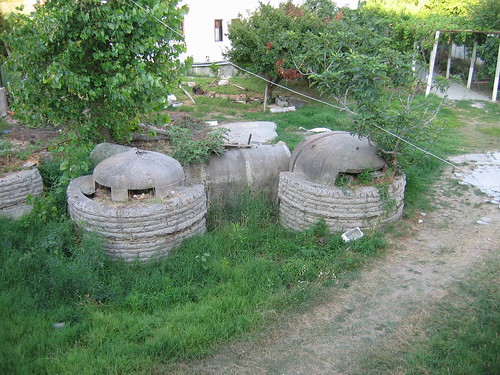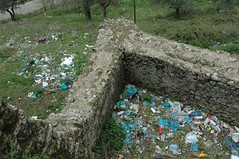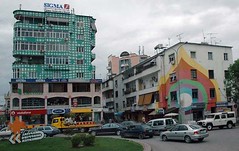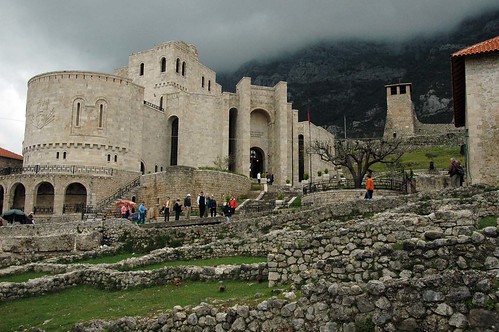Tuesday, April 14, 2009
Durres and Tirana
An author and lecturer on the tour, Paul Harris, describes Albania. He has traveled extensively in the country. He makes it sound like a Marx Brothers movie with real bullets. He says that every house has a Kalashnikov rifle and that nine out of every ten cars is a stolen Mercedes. I didn‘t believe him. That night I asked the captain of the ship. He said that sadly it is true. There is a huge trade in stolen vehicles. Later on Kela, our guide, tells me that it was true about the Kalashnikov rifles, but only up through 1997. Now they are all gone. Now I’m not sure I believe her. She says the only rule Albanians follow is that there is no rule. Her comment, made only half in jest, adds to the picture of Albania as the wild west of southern Europe. When a few days later I asked Kristina, our Dubrovnik guide what the Croats think of the Albanians, she said that they didn’t think of them at all.
Durrës was one of the major cities along the Via Egnatia, an ancient road that linked Durazzo (the Venetian name for Durrës) with Constantinople. Knights of the First Crusade came though Durrës in 1097. Some, like Raymond of Toulouse, sought and received letters of safe conduct from Emperor Alexius Comnenus’ family as Raymond and his fellow knights made their way to Constantinople and ultimately Jerusalem.
I find it strange to reconcile the past with the present. The First Crusade is the beginning of a violent clash between two cultures that a thousand years later invades my own life. It is like a feud between the Hatfields and the McCoys that will never go away. The Crusades have taken on mythic proportions. When I see a place where one of its ghosts still marches, a place like Durrës, I find it hard to reconcile my conjured idea of the mythic past with its dingy, dusty, dreary, and mundane present. Certainly, the past was just as dingy.
As we drove away from the dock at Durrës, we passed an unkempt plot of ground that appeared to be the yard of a private home. Three hemispheres peeked up out of the earth like R2D2 clones. These were bunkers built by the Communist dictator, Enver Hoxhe, shortly after he took power at the end of the Second World War. They added paranoia to the anonymity. Not looking good.
For a thousand years there were no nation states in the Balkans, just groups of tribes united by common languages. The land here fell first within the hegemonic grasp first of the Byzantines and then of the Ottomans. Some historians do not see a sharp distinction between the two eras. The distinguished Romanian historian, Nicolae Iorga, argued that there had been “a Byzantium after Byzantium.” And, of course, from the 11th century through the 18th there were those pesky Venetians dominating the Dalmatian coast.
In Kurje we visited a folk museum. At one point the guide, an old man who spoke English in phrases rather sentences, pointed to two stone wheels.
“Stones for grinding flour,“ he said. “Are two hundred years old.” That’s about as old as Albania as a nation. Montenegro, on the other end, has been an independent state for just three short years.
What brought nationhood to the Balkans? The answer is the great powers of Western Europe. The Balkans was caught up in the struggles between a Christian Europe and Eastern Orthodoxy and then between a Christian Europe and the Ottoman Empire. For five hundred years the Ottomans called the area, not the Balkans, but the Rumeli, the “Roman lands,” that they acquired along with the conquest of Constantinople in 1453. So what was it that brought national boundaries to a boundary-less land and along with it the vast eruptions of violence that many of us have witnessed during our own lifetimes? Arnold Toynbee put it this way in a passage quoted in Mark Mazower’s A Short History of the Balkans:
The introduction of the Western formula [of the principle of nationalism] among these peoples has resulted in massacre…Such massacres are only the extreme form of a national struggle between mutually indispensable neighbors, instigated by this fatal Western idea.”
Mazower expands on Toynbee’s point:
“Ethnic cleansing”---whether in the Balkans in 1912-1913, in Anatolia in 1912-1922 or in erstwhile Yugoslavia in 1991-1995--was not, then, the spontaneous eruption of primeval hatreds but the deliberate use of organized violence against civilians by paramilitary squads and army units; it represented the extreme force required by nationalists to break apart a society that was otherwise capable of ignoring the mundane fractures of class and ethnicity.
In other words, according to Toynbee/Mazower the Balkan Peninsula was the Africa of southeastern Europe. Just as the great powers of Europe descended on the dark continent during the so-called “scramble for Africa” of the 19th century and arbitrarily divided up the spoils of a land unhampered by national boundaries to the vast detriment of tribal boundaries, so, too, did they force national boundaries on the Balkans, opening the way for the bloody and fractured history that we have come to know from a distance during our own life times.
As we visit the various Balkan nations, then, beginning with Albania and making our way through Montenegro and Croatia, we will be looking at the results of overlaying nationalism on regions that were “otherwise capable of ignoring the mundane fractures of class and ethnicity.”
It is well beyond my capabilities as a travel journalist to unpeel the complicated onion of each country, but that, I think, is the task facing the historian of this area and what every tourist passing through the Balkans must keep in mind. Begin with the harsh fact that tribal units were forced at the point of a gun into the Procrustean bed of nation states. Then work back to see what infernal mischief that wrought.
That is the rub with Albania. Tomorrow when we visit Kotor we will find a tidy city with one of the world’s best natural harbors. The town is beautifully maintained—clean streets, winding alley ways, picturesque aspects at every turn of the head from the vantage point of an immaculate public square, The elegant influence of the Venetians to whom the people of Kotor turned in 1420 when they found themselves besieged by local clans and unable to protect themselves is evident everywhere.
In Tirana, on the other hand, the capital of Albania, the only influence visible is that of the communist regime of Enver Hoxhe, a merciless regime that traumatized the Albanians for forty two years, driving the populace into a state of cultural catatonia.
Take our first visit to the National Museum. The doors open at 10am and we step into a room lined with pictures of dead men. It is as if our first taste of cultural Albania is the city morgue. There are film loops playing constantly showing the execution by the Communists of members of King Zog’s government. Not all the dead are court ordered executions. Many were shot trying to escape Albania after the Communist take-over.
Why in the world would Albania put such an angry first step forward in introducing visitors to its country? I think the answer is that it wasn’t tourists the museum authorities had in mind when they designed their dreary recollection of Albanians dead and dying.
In 1836 John Stuart Mill, the great British philosopher, wrote:
The spectacle, and even the very idea of pain is kept more and more out of sight by those classes who enjoy in their fulness the benefits of civilization…It is in avoiding the presence not only of actual pain but of whatever suggests offensive or disagreeable ideas that a great part of refinement consists.”
We saw an excellent example of that during the Iraq War. The Bush administration forbade photographs of dead American soldiers returning home in caskets. The reason given was not wanting to intrude on the privacy of the surviving families, which is another way of saying that we didn’t want to let the nation grieve with them. Obama rescinded the policy as soon as he took office.
In the Museum I watch a group of school children pass in front of the exhibit. There must have been twenty-five of them. Only one wore a head covering in a country that is 70 percent Muslim. But whatever the religious makeup of the children might be, it was clear to me that this exhibit is for them. If Albania doesn’t look like a country of refinement, I suspect it is because the Albanians don’t want it to be. I think they want to remember how miserable the recent past has been. The exhibit is a warning of what was and what will come again if they don’t remember.
Everyone has been struck by how much trash one sees. The banks of the river that runs through town look like the town dump. Along the roadside wherever there is open land waiting for a builder’s backhoe, you will see a tangle of plastic bottles, empty paper boxes, discarded Styrofoam cartons, the flotsam and jetsam of a consuming society. These eyesores strike us as an outward manifestation of a slovenly character. Perhaps.
But perhaps the trash in the rivers and by the roadside and in the streets is not the sign of a country whose citizens don’t give a damn, but rather the sign of a country that needs to be reminded of where it has been. The spontaneous outdoor dumps of Albania are not a reflection of a slovenly populace but the expression of an angry one. Perhaps the trash is meant to say, “This is what we’ve been for the last half century, a nation whose leaders treated us like trash. Let’s not forget that.” It is a form of samizdat.
That is changing, I’m sure. The current mayor, Edi Rama, is now into his third term. He returned to Albania in 1998 from a career as a painter and artist in Paris. The impact of that is apparent in the painted buildings along the main drag in Tirana. Anything to bury the drabness of the last fifty years. He has encouraged the opening of movie houses that show foreign films, perhaps old hat to us, but something entirely new to Tirana.
The Albanians may not know where they are going. But they know where they have been and they don’t like it. That is not completely true. When we drive to Kruje, we visit a museum touted as the best in Albania.
It is devoted completely to the 15th century figure of Skanderbeg, the Albanian hero who single handedly reined in the seven warring tribes of the area and rode them against the occupying Ottomans like the wagon master behind the Budweiser Clydesdales. Statues have him looking like a bearded Arnold Schwarzenegger. If the Albanians don’t look to their streets with pride, they look to Skanderbeg. There is a statue of him in the center of Tirana.
Skanderbeg’s real name was Gjergj Kastrioti. As a child he was sent to Turkey to be educated. There his military talents emerged and he was given a new name, Icsander, i.e., Alexander. Beg was a suffixed title, Lord Alexander, no doubt meant to recall Alexander the Great.
Did Skanderbeg really exist? Well, of course he did. But I mean was he the hero that the Albanians say he was or the hero the Albanians need. Every emerging country needs an identity. Virgil’s Aeneid was written to provide Rome with a past. Skanderbeg is Albania’s Aeneus. Once we were kings, the memory says. In Gibbon’s Decline and Fall of the Roman Empire Skanderbeg is seen, not through the eyes of the Albanians, but with a far more jaundiced eye:
The enthusiasm of chivalry and religion has ranked him with the names of Alexander and Pyrrhus; nor would they blush to acknowledge their intrepid countryman: but his narrow dominion and slender powers must leave him at a humble distance below the heroes of antiquity, who triumphed over the East and the Roman legions.
The problem with the kind of thinking that looks to the past for present dignity is that it signals a lack of imagination. The desire of the Muslim world to return to the brilliance of its Ottoman past is another example of this lack. My hope is that Albania won’t allow itself to continue looking back in anger. It may take something akin to a good swift kick in the pants. Here’s hoping.








